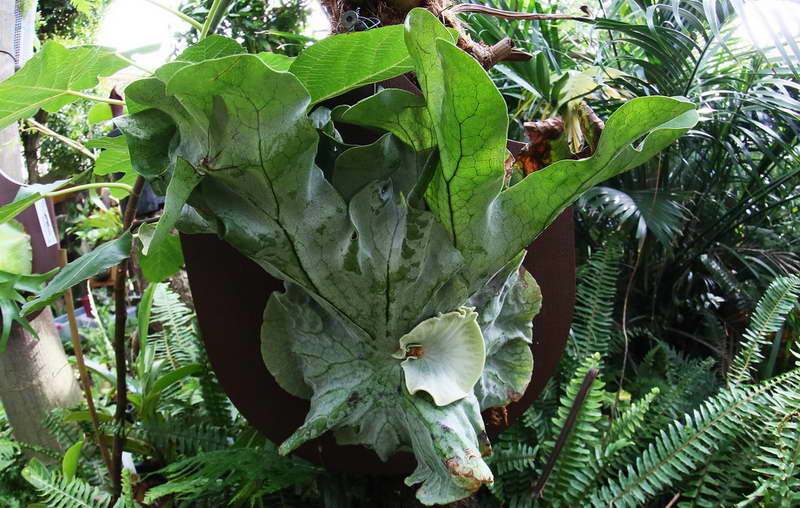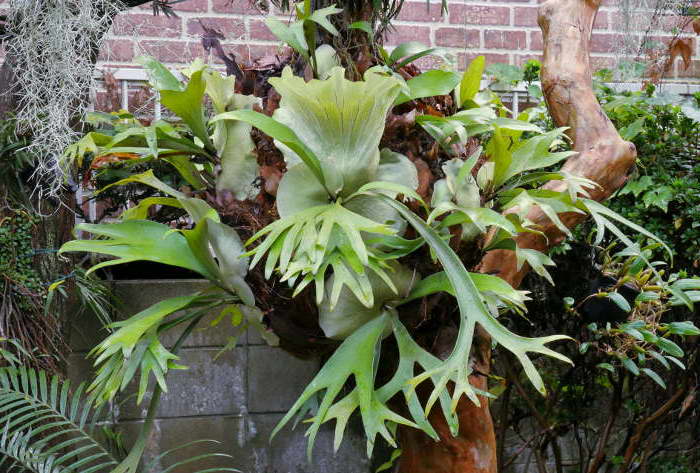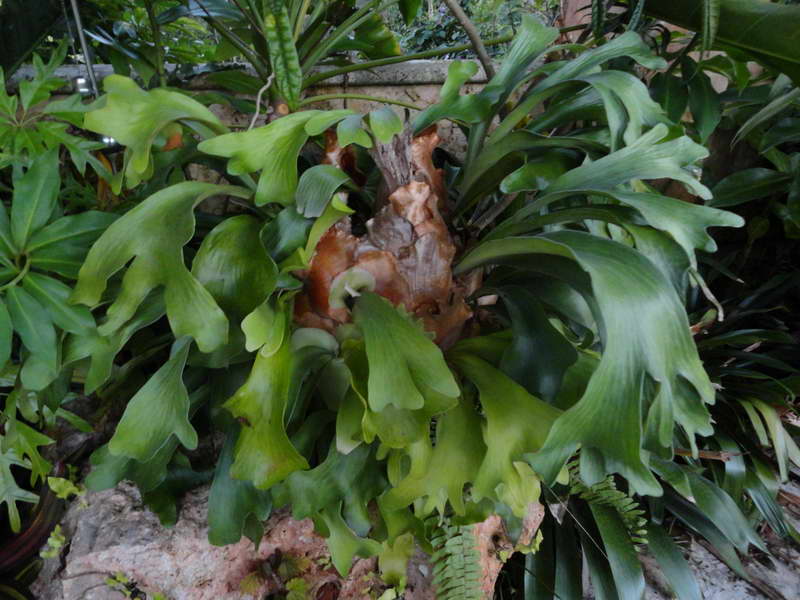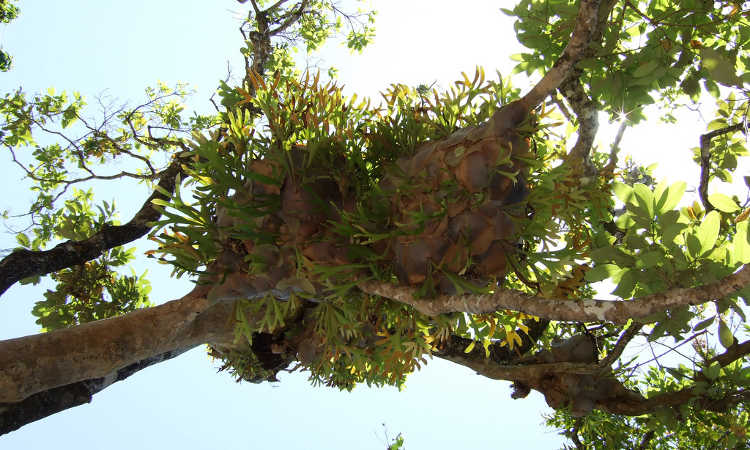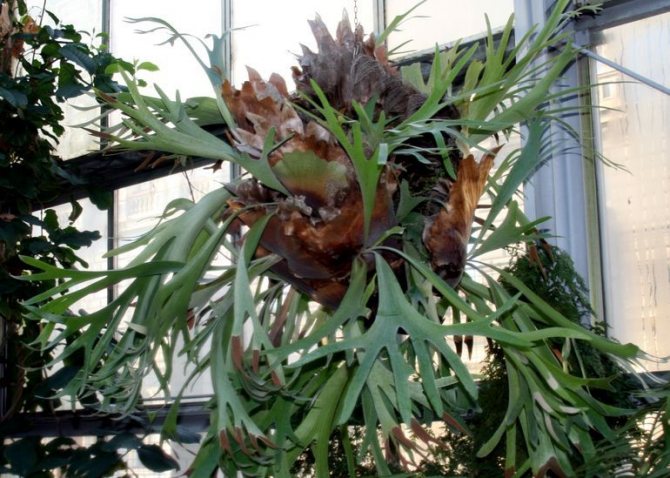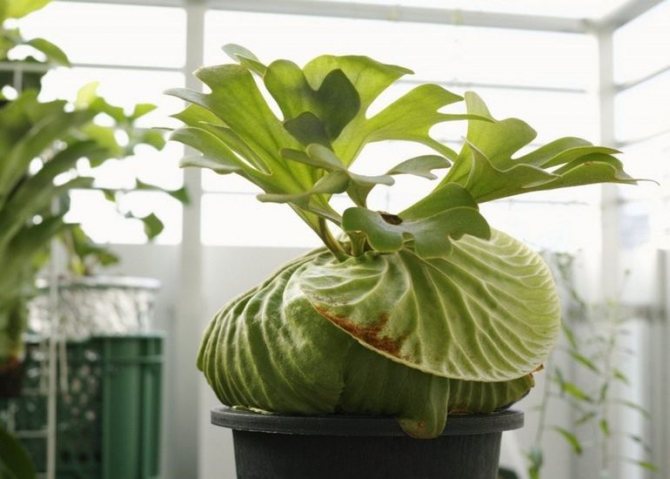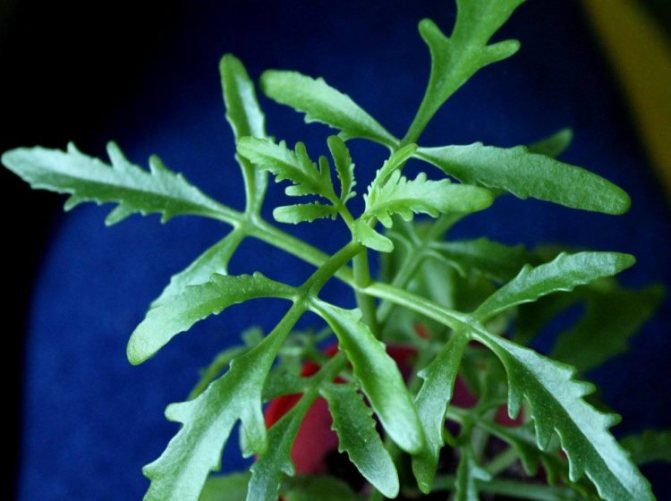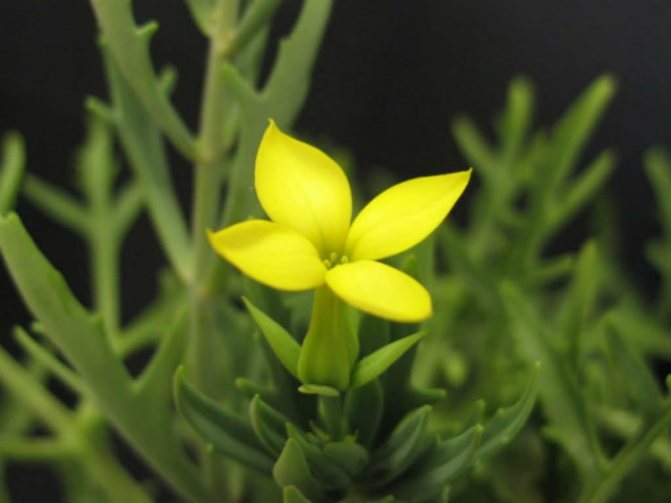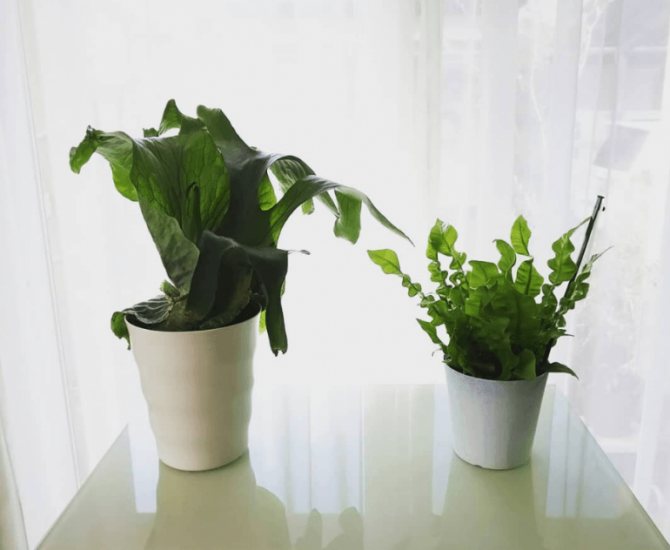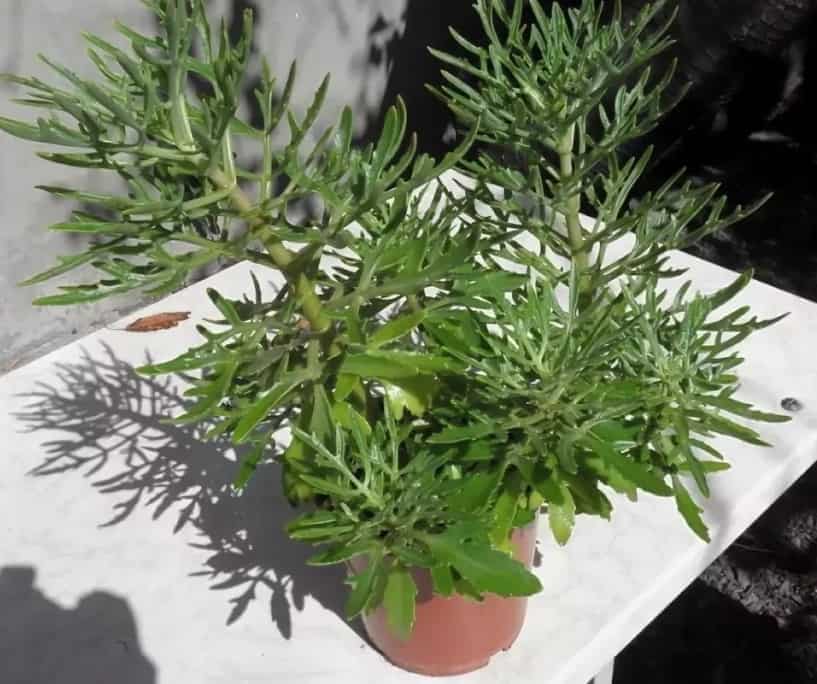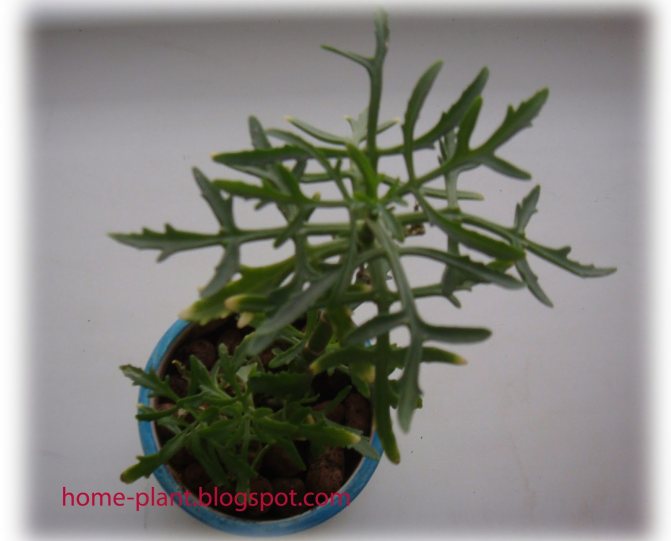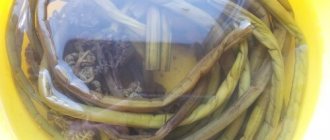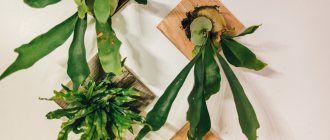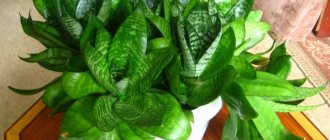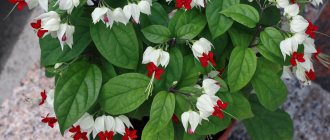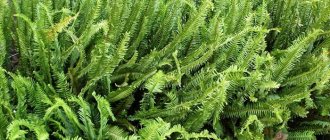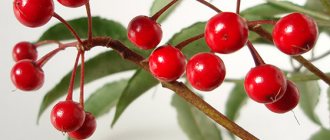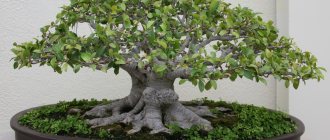Platizerium care at home
Illumination
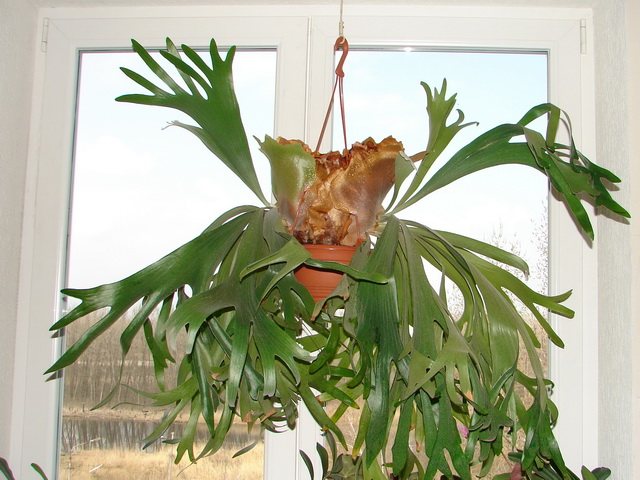
Loves light, but does not tolerate the direct rays of the sun, from which shading should be done. In winter, a south window is quite suitable for placement, but the plant will need to be protected from the sun.
Temperature regime
Loves warmth very much. So, in the summer, it is kept at a temperature of 18 to 25 degrees, and in the winter, the room should be no colder than 15 degrees. Doesn't like drafts.
Humidity
Required high humidity.
How to water
Watering should be systematic and for this they use exclusively settled, warm and soft water. Make sure the fern roots do not dry out. If the Platycerium grows on the bark, then you can water it by dipping it into water for about half an hour.
Top dressing
Top dressing is carried out from April to September 2 times a month, using a complex fertilizer for this (1/2 of the recommended dose).
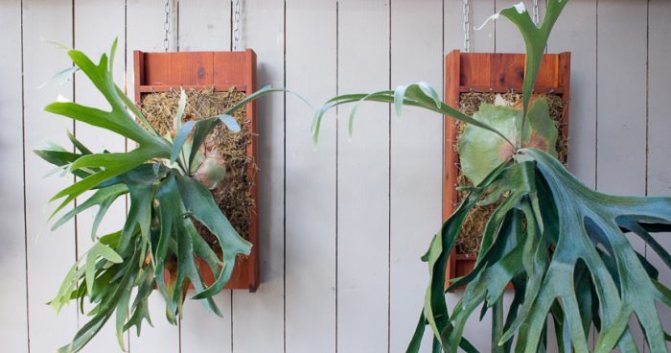

How to transplant
As a rule, the transplant is not performed. However, in springtime, it is sometimes possible to wrap the bark with the fern with fresh sphagnum and place it in a container that is more voluminous than the previous one.
Earth mixture
A soil mixture suitable for growing such a plant consists of sphagnum moss and tree bark, to which fern roots are also added. And you can also take a mixture consisting of leafy earth, with not completely rotted leaves, moss, as well as coarse-fiber peat. You can buy ready-made soil mixture for orchids.
How to propagate
This plant is not easy to propagate. It happens that side shoots are formed on it, and it is quite possible to separate them and plant them in moist soil.
You should definitely know!
It is impossible to wipe the platycerium leaves, they are only allowed to be sprayed with soft water. The fact is that tiny hairs are located on their surface, which are able to trap liquid directly from the air.
It is forbidden to cut off dead anchor leaves!
Transfer
This event can only be held for young plants. But it is strongly not recommended to transplant adult specimens, because as they grow, their sterile leaves tightly cover the pot, which is why they can be easily damaged during the procedure. In addition, the event affects the decorative appearance of the fern. After all, even if you manage to carefully separate the leaves from the flowerpot, then after transplanting they will no longer create a membrane dome, pressing against the surface. Therefore, Platycerium is transplanted only in extreme cases.
Nevertheless, it is advisable to change the bottom layer of soil by getting close to it from the bottom of the flowerpot. To do this, even during planting, you need to make several slots in the bottom of the pot or basket.
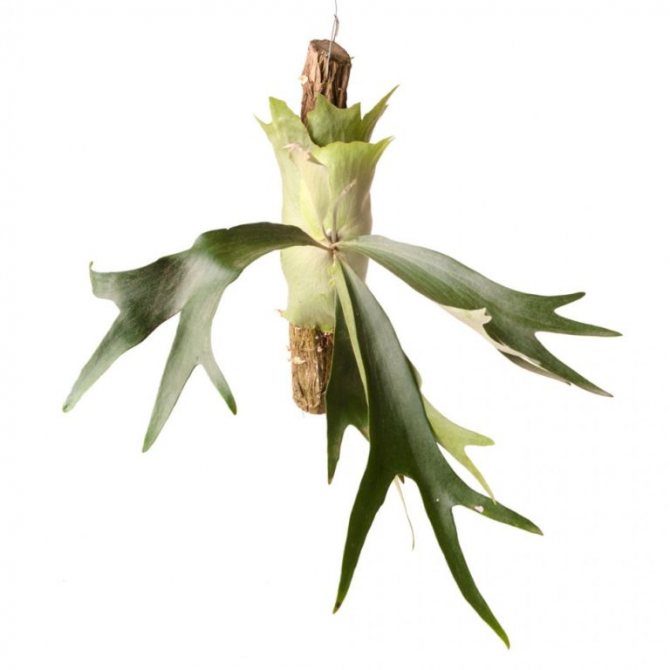

Types of platycerium
The platycerium fern grows in the tropical forests of Central Africa, there are about 20 plant species, but 4 species are grown in indoor conditions.
Angolan platycerium. It is characterized by triangular, solid, spore-bearing leaves up to 40 cm wide, extended towards the upper edge, which is pubescent in orange and has serrations on it. Sterile leaves are slightly bent at the edges and whole.
Did you know? Angolan Platycerium destroys gaseous carbohydrates and purifies the air in the apartment.
Platizerium large is a large plant native to Australia and tropical Asia.Its sterile leaves are wide enough, up to 60 cm, and are dissected at the ends. Spore-bearing - wedge-shaped, half of the leaf is dissected into belt-like strips. In length they can reach up to 2 m.
Platycerium two-forked, or Platizerium deer-horned, grows in wildlife in Australia. The most popular among indoor types of Platycerium. Its lower sterile leaves are rounded, convex and dissected, and the upper spore-bearing leaves are no longer than 70 cm, gray-green in color, wedge-shaped at the base, but expand towards the upper part.
Hill's Platitzerium - outwardly resembles the previous look, but more graceful and fragile. Its leaves are shallowly dissected, straight, separate segments pointed at the ends. Very similar to the previous view, but more miniature. The homeland of Platitzerium Hill is the Australian tropics.
Botanical description
The plant got this name for a reason. The appearance of its leaves really resembles the spreading antlers of a moose or deer.
The scientific name of this plant is Platierium (Latin Platicerium), which is part of the Centipede family (Latin Polypodiaceae). In total, there are about 15 species of this plant.
In home gardening, you can find two species that are acclimatized to the conditions of winter gardens or greenhouses: Platycerium bifurcatum and Platycerium grande.
This fern is very picky about growing conditions, therefore it is best kept in rooms with growth factors closest to the climate of natural growth of Platycerium. Platiterium loves large lighted rooms, warm offices, places with high humidity.
But still, gardeners have learned to adapt to the brisk disposition of the plant and you can find different garden forms that take root well in our latitudes.
The most attractive and valuable thing that Platycerium possesses is its irresistible foliage. Platycerium fronds have a very decorative look. For this reason, they like to use it in floristic compositions or complex landscaping of premises.
The leaves of the Platycerium, like many ferns, are divided into two types: sterile and spore-bearing. Platycerium develops on a support, around which sterile rounded leaves grow. Over time, they get stronger and become golden brown in color.
Thus, a natural bowl-shaped container is created at the base of the stem, in which water and other organic residues accumulate. The plant uses these substances to obtain nutrients from the external environment.
And those leaves, which attract many gardeners with their delicacy, are the "antlers". They have spores on the underside at the tips of the leaf plate. They are light green in color, long in shape and branched, covered with scales.
Due to the scales, the leaf looks pubescent. The same scales give the young leaves an almost silver color. Therefore, do not wipe them with a rag to moisten or remove dust.
This plant can only be sprayed if there is a desire to maintain the full ornamental appearance of the Platizerium.
Another feature of the Platycerium is that hanging planters or wide baskets, which can also be hung, are the most suitable growing containers. This is due to the natural growth conditions of the platycerium. Indeed, in tropical forests it grows just like that: on trees, delicately decorating their trunks with hanging leaves.
Reproduction methods
Disputes
This propagation method is practically not used in home floriculture, since it is very laborious and often does not give results.
The spores that are located at the ends of the spore-bearing wai from the lower side must be collected and dried. The spores are then placed on the surface of the soil. You do not need to cover them with soil.It is necessary to systematically moisten the soil, and cover the container on top with glass or film.


The first leaves of the deer antlers fern when propagated by spores will appear in 2 months
Spores need plenty of sunshine and high humidity to develop into adult plants.
Offspring
This breeding method is much easier. From time to time, young shoots appear in an adult fern. Wait until the offspring has developed enough roots and carefully separate the young shoot. It should be placed in prepared soil. Complete rooting of the offspring occurs in 2-3 weeks. The appearance of new leaves is a sure sign that the plant has taken root.
By dividing the bush
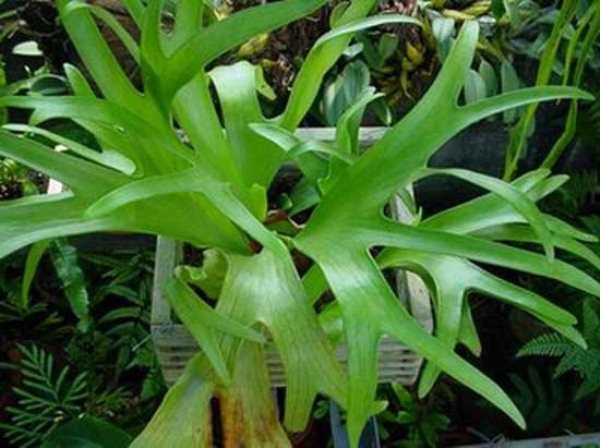

The easiest way to propagate the Deer Antler fern is by dividing the bush when transplanting
When transplanting, you can propagate the plant by dividing an adult flower. It is necessary to ensure that when separating, both parts of the plant retain the roots and wai of both types. Otherwise, the plant will die.
Reproduction
Antlers can be propagated in three ways:
- dividing the bush;
- offspring;
- disputes.
Let's consider each of the methods in more detail.
Dividing the bush
The order of reproduction of the Platycerium by the method of dividing the bush:
- During transplantation, carefully examine the plant bush.
- Mark the places where the cut can be made. They should be positioned so that healthy rhizomes and leaves remain on each of the cut-off parts of the fern.
- Use a knife sharpened and treated with alcohol to make cuts. Sprinkle the places of plant cuts with wood ash.
- Place each part of the antlers in a separate container.
This fern propagation method is the simplest and most effective.
Reproduction by offspring
Over time, the fern forms a daughter bush. At first, it is very weak and cannot exist separately from the uterine outlet. But over time, it gets stronger and begins to form its own root system. At this time, you need to carefully separate the offspring from the flower and plant it in a separate container. The advantage of this propagation method is that it is not accompanied by a mother bush transplant.
Reproduction by spores
Step-by-step instructions for breeding Platycerium using spores:
- Collect spores from the back of the spore-bearing wai and allow them to dry completely.
- Prepare a shallow container and fill it with the same soil as for an adult antler plant.
- Water the soil liberally and scatter spores on top of the soil. You do not need to deepen them.
- Cover the container with plastic wrap or glass to create a greenhouse environment.
- Place the container in a warm and bright place.
- Ventilate the greenhouse regularly and, if necessary, moisten the soil with a spray bottle.
- After emergence (after about 8-9 weeks), remove the film or glass.
- When the seedlings are old enough, transplant them into separate pots.
This method of reproduction of Platycerium is very complex. Therefore, it is used very rarely. But he has an advantage - thanks to him, you can get several dozen new plants at once.
Diseases and pests
The most common problems
These diseases are usually caused by improper flower maintenance.
- Kalanchoe Laciniata can get sick if it doesn't get enough light. Symptoms: Leaves turn pale, turn yellowish and fall off.
- If the leaves begin to wrinkle and fall off, there is little moisture and the temperature in the room is too high. It is required to normalize the temperature and humidity of the air.
- If the long-awaited flowering does not come, it means that the Kalanchoe is oversaturated with organic fertilizers, you should stop feeding for a while.
- After flowering Kalanchoe Laciniata can slow down in growth, begin to become bare, this is a sign of lack of nutrition. You can fertilize or renew, transplant a flower.
- Avoid stagnant humidity in the room and substrate.This usually leads to the appearance of gray mold. Signs: Leaves are covered with brown and then black spots.
Features of care in summer and winter
The Platycerium does not have a pronounced dormant period. From October to February, the flower should be allowed to rest. With sufficient lighting, the temperature for a flower in winter is + 15-17 ° С... The plant during this period is not fertilized or sprayed with water. Watering must be reduced, but at the same time, the earthen coma should not be allowed to completely dry.
In the summer, watering is increased. You can moisturize the plant by immersing the container with Platiterium in water for a few seconds.
Deer antler flower transplant
Platycerium is most often grown in shallow pots and hanging planters. But if you want to make the most of the decorativeness of the "deer antlers", then the plant can be transplanted onto a wooden block, imitating real deer antlers, as shown in the photo.


Only young ferns are well tolerated, more mature ones should not be disturbed. Sphagnum moss with peat particles and pieces of rotten bark and leaves are used as a substrate and a power source. On a prepared board with hammered in nails, a bed for "deer antlers" is formed with the help of fishing line and moistened moss. The backing layer should not be too bulky, 1.5-2 cm in thickness is enough.
Attention! Do not use copper wire to create the backing, as it can be detrimental to the fern.
The roots of "deer antlers" must be cleaned of the old substrate as thoroughly as possible, but very carefully. Then the platycerium is transferred to a new habitat, the sterile frond is pressed against the formed substrate and reinforced with a fishing line. The frond will grow and form a brace, so the sphagnum is distributed evenly, without any bumps and depressions.
After that, all that remains is to choose a place on the wall and reinforce the board with "deer antlers" to the delight of you and the surprise of your friends.
Attention! "Deer horns" will not only serve as a wonderful interior decoration, but also able to purify the air, filling it with phytoncides.
Applications in landscaping and neighbors
This plant is often chosen for Japanese gardens. In addition, it harmonizes well with horizontal coniferous crowns and gets along well with plants with blue needles. Another company for the vinegar tree is perennials: they look very beautiful with sumac in autumn.
The plant can also be used as part of rocky gardens. The vinegar tree itself is very unpretentious.
When planting it, designers pay attention to such its features as: the possibility of good anchoring of slopes and ravines and its frequent use for removing weeds, since this plantation grows very quickly and does not give harmful plants space for development.


Vinegar is planted along the fence or as a hedge.
The only problem associated with this plant may be the ability of sumac to grow, because it "swallows" not only pest plants, but also all benign plantings.
Did you know? The vinegar tree lives for about 15-20 years and dies off. But it revives again due to new shoots emerging from the root of the plant.
Growing difficulties


Platizeriums are grown in a suspended state or on pieces of bark, stumps, in wooden or plastic baskets, in pots
Novice growers sometimes have difficulties with watering and breeding reindeer horns. In addition, experienced flower lovers advise hanging the antlers. After all, this is how it exists in its natural environment. To do this, you can use a small log in the recess of which is filled with moss and a flower is fixed. A piece of bark can be used for the same purpose.
You can stick several knitting needles or thin sticks into a flowerpot with a flower and carefully fasten heavy leaves so that the flower does not fall under their weight.
Watering
Platizerium "deer antlers" is a moisture-loving plant that needs regular watering. Fern does not tolerate drying out of the soil, but stagnation of moisture at the roots is contraindicated for it. Therefore, watering should be treated responsibly. Moisten the soil as soon as the top layer dries. If sterile leaves have blocked access to the roots and you cannot assess the state of the substrate, then it is better to skip watering and irrigate when the frond plants slightly wilt and wilt.
In any case, only moisten the plant with soft, filtered and settled water at room temperature. In addition, experienced flower growers recommend using the bottom watering method, when a pot or block is dipped in a container of water and left for 20-30 minutes. So, you give the fern the opportunity to nourish the amount of moisture that it needs. After watering, do not rush to put the flowerpot in its usual place, but wait a few minutes for the excess liquid to escape.
Lighting and location
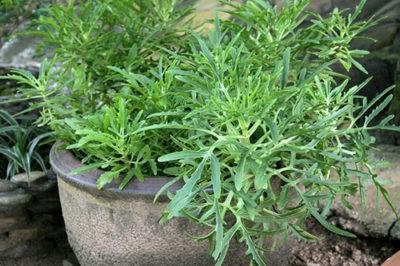

Kalanchoe Laciniata loves bright light, like any representative of the tropics. Therefore, you can install pots with a plant on any windowsill. Only the northern location of the Kalanchoe pot should be excluded. Here you will need additional lighting with special phyto lamps. Especially in winter and autumn, when daylight hours are shortened and the air temperature is lowered.
After a long winter, when the sun is not enough, cloudy days prevail, it is not recommended to immediately expose the pots to the spring sun. Gradually "tame" Kalanchoe Laciniata to bright sunlight to avoid burns on leaves and flowers.
You cannot keep the pot in partial shade for a long time, the Kalanchoe Laciniata will begin to wither, it needs sunlight.
The peculiarity of Kalanchoe Laciniata is that it is very resistant to dryness, it can be grown near radiators in the autumn-winter period.
In the summer, it is not necessary to spray the leaves. Only on the hottest and sultry days can you sprinkle a little with cool water. The Kalanchoe Laciniata does not require constant spraying.
Lighting
Platycerium "deer antlers" is a light-loving plant, but direct sunlight is contraindicated for it, because from them the leaves of the culture get severe burns and wither. Therefore, choose the east or west side of the room to grow your fern. The plant will take root in the north, but here it will need additional lighting with a phytolamp.
If you plan to grow a fern exclusively under artificial light, then keep in mind that the illumination level must reach at least 4300 lux. And the length of the day should be at least 10 hours a day.
Features of growing a home fern
It is worth choosing a western window for the fern, the optimal temperature and humidity.
Choosing a location: what should be the lighting, temperature and humidity
The home flower antler grows best in bright, but shaded places from direct sunlight. The sun is very dangerous for the leaves, it can cause burns and seriously harm the Platycerium. If there is not enough light, you need to additionally illuminate with a lamp. In an apartment, it is worth maintaining the temperature in the summer + 20-25 ° C, and in the winter - + 20-22 ° C, the temperature below +15 ° C is harmful to the platycerium, can provoke its death.
Platiterium tolerates apartment dryness very badly. To ensure proper care, the Platizerium flower should be placed on a pallet with expanded clay or suspended over the aquarium. The plant needs very high humidity, it should be sprayed with warm boiled or purified water. Spraying with running water is prohibited due to the fact that on the surface, the smallest leaf scales can clog, which can harm the Platycerium.
Humidity and watering
Platizerium prefers high humidity.However, it is categorically impossible to wipe the leaves - there is a risk of damaging the tiny velvety hairs on the surface that trap moisture from the air. Therefore, it is enough to periodically spray the "horns" from the smallest spray so that the water does not remain on the leaves with drops.
If there is an open aquarium or other source of moisture in the room, it will be useful to place the Antlers closer to it. As an additional measure to increase the air humidity, you can pour wet expanded clay or pebbles into the pot tray so that the bottom of the pot does not touch the moisture. Placing the plant in a room with a humidifier or near the aquarium will be a good idea.
How to take care of it properly?


Watering for Kalanchoe Laciniata should be moderate. We monitor the condition of the upper layer of the substrate - when it dries completely, watering is required.- In summer, on especially hot days, we water it 2 times a week in small doses.
In winter, we reduce watering, once every 7 - 8 days is enough, Kalanchoe Laciniata can get sick with excessive watering, it is prone to decay of the trunk and leaves.
- Temperature. Kalanchoe Laciniata tolerates heat well. The temperature regime in summer is up to 28 - 30 ° C, in winter the required air temperature is 12 - 15 ° C. The most optimal temperature for keeping a flower is 17 - 18 ° C.
Beware of overheating the air, if you keep Kalanchoe Laciniata at a high temperature, flower buds will not form, and you most likely will not wait for flowering. But the flower should not freeze either, this causes the leaves to drop. - Fertilizer is best combined with watering. In summer, it is advisable to fertilize with mineral fertilizers, once every 6 to 8 days is enough, and any organic fertilizing is applied no more than 1 time in 14 to 16 days.
We water only with settled or purified water. Water can be poured into a drip tray to prevent it from spilling onto the leaves.
With a lack of moisture, Kalanchoe Laciniata loses its leaves. Shriveled leaves are a sign of a lack of watering. But even on summer days, the flower does not require spraying.
What does it look like
Sumach fluffy or deer-horned, vinegar tree or as it is called in Latin Rhus typhina is a representative of the Sumach family, which grows mainly in the northeastern part of the United States and southeastern Canada. This deciduous tree grows up to 8 m tall.


In the Moscow region, the height of the deer-horned sumach will not exceed 3 meters at the age of 4 years. The leaves are 6-11 cm long, pointed, serrated at the edges, and white on the inside of the leaf. Each leaf is “assembled” on branches into a “commonwealth” of 9 to 31 leaves.
Sumac blooms in early and mid-summer. The flowers of the planting are very beautiful, red-brown or light green in color. Each flower has stamens and a cone-like shape. The average flower length is 15 cm, the diameter is about 5 cm.
Did you know? Sumakh is used in Central Asia as a seasoning for meat dishes, instead of vinegar.
In autumn, the leaves turn red and the tree turns red due to the color of the foliage, and after it falls off, fruits appear on the sumac, which have a pyramidal shape. They are not interesting to birds, which means that you can admire them for a long time. They keep on the tree until next spring.
The tree grows upward only in the first years of life, then it grows in breadth. Sometimes the planting resembles a shrub because of such a wide crown.
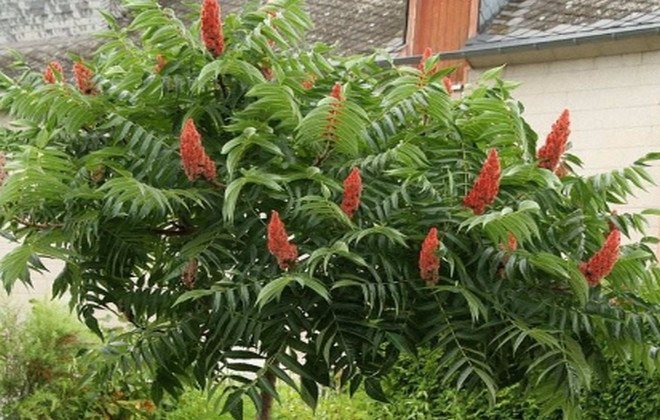

The best tips for taking care of your Platycerium
Proper care is the key to good fern development.
Watering
The antler flower needs regular watering and it is worth knowing how to properly care for it. Water for irrigation should be at room temperature and filtered. Watering itself is plentiful, but it is worth waiting until the topsoil dries up. A basket with a platycerium is immersed in a container of water, after the flower is saturated with moisture, taken out of the water and left without watering for several days. If the fern is grown in a regular flowerpot, make sure that moisture does not accumulate in the pan to prevent the roots from rotting from the bay.
Top dressing
Reindeer antlers are like a wayward flower in the obligatory care includes constant feeding. Fertilize once a month when watered with special fertilizing for ferns, using ½ of the concentration specified in the instructions. Some gardeners advise putting scalded tea leaves or pieces of banana peel under the dome, which forms sterile leaves.
General information
The frond plant has two types - sterile and spore-bearing. At the bottom of the fern, sterile fronds grow, which retain their green color in autumn, and dry and turn yellow in spring and summer. It would be a big mistake if you decide to trim them. These leaves are an important source of root nutrition.
Spore-bearing leaves begin to perform their main function late - it is necessary that the fern be at least five years old. These fronds are covered with white threads, which serve as protection from light and conserve moisture.


[collapse]
Soil requirements
The substrate is best purchased from a store, labeled for succulents or cacti.
For the first option, you will need:
- sod land - 1 part;
- sheet land - 1 part;
- coarse river sand - 1 part;
- vermiculite -1/4 part.
You can also use:
- universal soil - 2 parts;
- coconut substrate -1 part;
- vermiculite - 1 part;
- humus - 1 part.
Another substrate option:
- light loam -1 part;
- coconut substrate -1 part;
- zeolite cat litter - 1 part.
Important: you can add pieces of birch charcoal, humus to the substrate. Drainage from expanded clay of medium pieces is required.
Useful properties of deer horns
Deer antlers perfectly clean indoor air. They saturate the surrounding air with phytoncides, which have a beneficial effect on humans. Moreover, Deer antlers actively absorb hydrocarbon compounds from the air... For example, they perfectly clean indoor air from gasoline vapors and automobile exhaust gases coming from the street. This ability of the flower is becoming very popular, thanks to the increased number of cars on the streets of our cities.
Care in an apartment
In order for the "deer antlers" to please you with its appearance, several conditions must be met:


- Avoid the scorching rays of the sun, and create a shade that mimics the natural conditions of the plant (like under the crown of a tree). With artificial lighting, Platiterium is unlikely to survive.
- Needs fresh air, but the fern is sensitive to drafts.
- The humidity level in the room should be in the range of 60-80% (do not forget that "antlers" are tropical plants). If the air in the apartment is very dry (which is often observed in winter with increased heating), a container of water can be placed near the fern.
- The optimum temperature is 20 ° C. An increase in the temperature regime requires an increase in the level of humidity.
- The soil should be well-drained (a mixture for orchids - soil and bark 1: 1, but you can use bark and sphagnum moss).
- Watering is regular, but do not overdo it. with an excess of water, the "antlers" can rot. It is better to focus on the top layer of the soil - if it is slightly dry, you can water it. Spraying is encouraged (in winter it is better to refrain from this procedure). Stick to the rule - the more moisture, the less watering.
- During the growing season (spring-summer), the antler flower needs feeding every 2 weeks. Water-soluble orchid or fern fertilizers work well for this purpose. During the dormant period (autumn-winter), feeding once a month. Some growers, as a top dressing, lay a banana peel behind a rounded leaf frond.
Advice. It is not necessary to wipe the Platitzerium fronds, because this procedure can damage the small hairs that cover the fern, and this can even lead to the death of the plant.
How to choose the right seedlings when buying
It is best to buy seedlings in proven nurseries: there they are definitely taken care of correctly. Consider the small plant carefully before buying. The seedling should be symmetrical, with normally developed leaves. If it is a little crooked, it means that it was cut off.
The rhizome must be well formed and developed. If the root is damaged, the plant will soon die. It is better that you are offered a lump formed from native soil: this way you will know that everything is in order with the root system.


Next, look at the leaves. They shouldn't be withered and lifeless. Good seedlings always have firm leaves that should not dry out at the ends. Also, there should be no mold and cobwebs: this indicates a plant disease or the presence of harmful insects.
A good specimen has a root system without rot and spots. The firm roots should be well buried in the ground. If the plant has too large flowers or an unnatural green color, then it is too overfed with nutrients.
You should not buy it, as it will hurt and may die before your eyes. Now that we figured out how to choose a plant, let's figure out how to plant it.
Plant care
- It is better to keep the plant in the western or eastern windows, like other ferns. That is, the sun is not required the hottest. Deer antlers need protection from direct sunlight. At the same time, the flower loves good diffused lighting.
- The plant does not tolerate drafts, cold harsh air, although regular ventilation of the room in which it is located is necessary. The deer horn does not tolerate dust and smoke well.
- For good growth in the spring-summer period, the optimal temperature will be about 20 ° C, when the temperature exceeds 24 ° C, the air humidity should be high, because the plant does not tolerate high temperatures well. In the autumn-winter period, the optimum temperature is 15-17 ° C. Too warm air will harm the antler, so it is not recommended to place it near central heating radiators.
- Since most ferns are native to rainforests, these plants do not tolerate dry air well. In this regard, the flowers must be regularly sprayed at least twice a day, on hot summer days - 3-5 times a day. In warm rooms, the plant is sprayed with warm water.
Description and features of the plant
Platycerium - belongs to the botanical class of Fern, its genus (Centipede) is small - 17 species. Out of the oddities besides the extraordinary appearance:
- Root - aerial (i.e., ground);
- By its nature, the plant is an epiphyte: it lives only on another organism - a tree, without causing harm. Including not a parasite.
In natural conditions, leaves (frond) reach 1 m, at home - up to 50 cm. In the wild, it is found in the Eurasian and African tropical zones.
Where and how to plant?
We transplant young Kalanchoe Laciniata once a year:
- We process the pot for disease prevention.
- Place drainage on the bottom of a small pot - pebbles, expanded clay, pieces of cut cork, 4-6 cm.
- Easily, without trampling, pour in moist soil.
- We deepen to the level of the neck, make a small depression.
- We fertilize the soil.
An adult flower is transplanted every 3 to 4 years as needed:
- The transshipment method is used.
- The pot is required larger than the previous one.
- At the bottom, on one third of the volume of the pot, we pour a drainage base - expanded clay.
- We place the root shallowly together with the old earthy clod.
- We fill the space of the pot with new soil.
- We apply fertilizers.
Important: during the flowering period, Kalanchoe Laciniata cannot be transplanted.
Adaptation after transplant usually does not last long - 1 - 2 weeks. The pot is suitable for a shallow one, since the Kalanchoe Laciniata has a weak root system.Be sure to put a thick layer of drainage base on the bottom of the deep pot to prevent root rot.
How to transplant a platycerium to an epiphytic block


The root system of the Platycerium is small, even young plants are transplanted once every 2 years, adults - even less often.
1. Prepare plants for transplanting. There are no specific requirements for their size, just in order for the seedlings to survive, the leaves must be at least as large as the palm of an adult.
2. Cut the plants out of the pot. To remove the plants, do it carefully so that the roots do not break. Use a knife as a tool. Make a puncture with a knife at the edge of the round pot to separate the seedling from the pot. Then rotate the pot and continue to remove the earthy ball with a knife. Even if the pot breaks, it will not break the roots.
3. Remove plants with an earthy clod and move them to a horizontal block.
4. Add sphagnum moss. To speed up the engraftment of Platycerium roots on the epiphytic block, it is necessary to add a little sphagnum moss between the antler roots and the block. It's a good idea to add moss on top of the earthen clod as well as on the sides. This will trap more moisture when watering and speed up root growth.
5. Anchor the plants. Once you add the moss, secure the plant to the block with rope or thin wire. It is enough just to tie it crosswise twice.
Platizerium is often grown on pieces of bark (you can hang such a structure on the wall - like deer antlers, only green) or in hanging baskets. Attach to the tree with the help of sphagnum moss and fishing line, inside the lower leaves ("head of cabbage") it is advisable to pour a little leaf humus. As it grows, the gap between the piece of bark (or epiphytic block) and the leaves increases - add leafy soil there every spring, you can never remove old dry leaves, they will rot and feed the Platycerium.
Fern platycerium: care and features of nursing
This fern species is quite capricious. The main difficulty of care is maintaining the necessary air humidity in the room in which your pet lives.
- The northern side is considered the most favorable for cultivation. It does not matter to Platitzerium whether it will be light or dark, it is shade-tolerant.
- Direct sunlight should not hit the leaves. Often, a flower does not require natural light at all, it can grow in full artificial light. Although there is a completely opposite opinion that with a lack of light, the fern does not form spores.
- It is unpretentious to the climate, but it is better not to allow sudden temperature jumps, to make sure that the thermometer does not drop below 13 degrees. In summer, with abundant watering, it even tolerates a heat of 37 degrees.
- The fern can be cultivated on bark or a piece of wood. The growing substrate is made up of a mixture of peat, humus, pieces of bark, chopped moss. If you decide to buy ready-made soil, buy a specialized "For ferns".
- The plant is very moisture-loving, requires abundant watering and does not tolerate the drying out of an earthen coma.
- Spraying procedure is mandatory. But it is strictly forbidden to wash the leaves and even just wipe them with a damp cloth.
- It is advisable to fertilize during the active growing season. We alternate mineral fertilizers and organic ones.
- An annual transplant with the removal of decayed roots is desirable.
- It reproduces in two ways:
- Division of rhizomes.
Disputes.
For sowing spores, it is necessary to use shallow containers like Petri dishes (pictured)


Platizerium: description of indoor fern


The indoor flower deer antler is a large epiphytic plant with a branched rhizome, its aerial roots are in the zone of the upper leaves and under the rhizome scales.
Platycerium leaves are sterile and spore-bearing; they also differ morphologically.Sterile leaves are wide, round and sessile, adjoining the trunk and branches of the host tree with a free upper edge, which forms a niche, precipitation and humus from fern leaves fall into it, which die off.
Humus accumulates over time and can serve as a substrate for plant roots; with age, the mass can reach about 100 kg. Spore-bearing leaves are flat, on short petioles, with a dense skin, erect or hanging down, giving the impression that the flower looks like deer antlers. Sporangia are responsible for photosynthesis and reproduction; they do not collect in sori, but are simply scattered on the apical part of the leaves, giving the lower part a red tint.
Planting and reproduction of platycerium (deer antlers) at home
Platiterium is capricious, and taking care of it at home takes a lot of effort. Platizerium is often grown in hanging baskets or on pieces of tree bark. When choosing the second option, the plant is fixed on the bark with wire, and a little earth is poured under the lower leaves. Platycerium increases in growth, and the gap between the bark and leaves also, so the soil should be added, but you do not need to remove the dried lower leaves, they are beneficial to the fern. In the case when the Platitzerium is planted in a pot, it is necessary to pour a layer of expanded clay on 1/3 to maintain the moisture of the earth and protect the roots from decay if they are flooded with an excessive amount of water.
Like most ferns, the antler flower reproduces with the help of spores that germinate only in a bright place, and the germ develops normally only in a humid environment, and therefore the spore crops must be kept under a transparent cap. It also propagates by shoots (they are separated from an adult plant and planted in separate pots filled with pebbles and moss) and division (a young plant is separated and planted in different containers)
[collapse]
Brief description of the plant
The real name of the flower, which is popularly called deer horns, is platiterium. Translated from Greek, this means “flat horns”. It is a slow growing fern that can grow up to 1 meter in the wild. In its natural environment, it is found in Africa, Australia and Asian countries with tropical climates.
Platiterium differs from other indoor flowers in its unusual leaves: they are thick, fleshy and heavily cut, like antlers. They are painted light green and have a waxy luster. Another distinguishing feature is the presence of a core in the plant, which is similar to a cabbage head.
It is interesting! In some descriptions, you can find a few words about how beautiful deer horns bloom. In fact, this plant never forms peduncles, because it is a fern. No matter how you care for it, you can never make it bloom. However, there is a flower that is also called deer horns due to its external resemblance to a fern. But in fact it is a dissected Kalanchoe.
We plant correctly
Experienced gardeners recommend purchasing cuttings previously grown in pots in soil with extended-release fertilizers. They can be planted from spring to late autumn and even during the hottest period. The root system perfectly retains its properties and there is a guarantee of good survival. At the same time, you do not have to additionally independently fertilize the soil.
If this is not possible, a neutral or slightly alkaline soil composition should be prepared. Sod land, sand, humus are suitable for the planting hole. Then digging up the ground around the seedling is not necessary and desirable, you can damage the surface roots.
A freshly transplanted vinegar tree (as it is called differently) must be watered abundantly. At the end of the day, the root soil should be mulched with a dense peat mass.Watering is rarely done, and top dressing is done once a year. For this purpose, a complex of mineral fertilizers (up to 50g / 1 sq. M.) Is suitable.
In winter, in extreme cold, it is necessary to warm up a snowball around the tree in order to protect the roots from freezing. The cover must be large enough.


A little about reproduction
Reproduction of an ornamental tree is carried out both by seeds and by root shoots. The second method gives the best effect. In the place of dug out shoots, new ones immediately appear, a little later they will be ready for an independent life.
It takes some effort to grow sumac from a seed. Fresh seeds are taken for sowing. Within two months, they should be treated with a solution of boiling water and sulfuric acid.
For those who are interested in the plant, it will not be superfluous to know that:
- only the female tree bears fruit
- Central Asians use crushed vinegar tree powder as a spicy additive with a sharp and sour taste for cooking meat, fish, barbecue, and barbecue dishes. It perfectly replaces lemon, vinegar. The dish gets a spicy aftertaste and a pleasant color to the eye. The fibers of the meat soften easily, the dish turns out to be tender, soft. The powder works well with other additives. Its color also stains other foods in the dish. For example, beans, rice, pickled onions
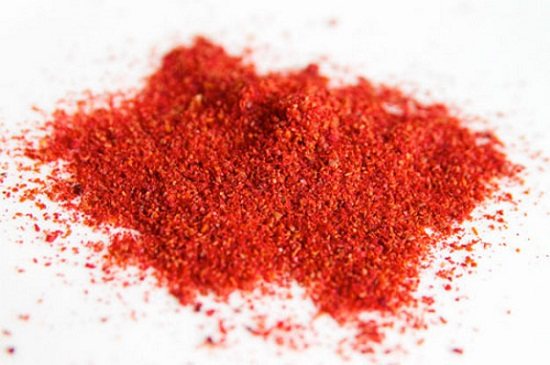

- the main reason for planting such a tree is the presence of medicinal properties in the fruits
- from sumach fruits, you can prepare a tincture that regulates metabolism with strong fat deposits, atherosclerosis, type 2 diabetes mellitus
- roots located close to the surface, contribute to the growth of new shoots, having dug out one, numerous others will immediately appear. Thanks to this, the breeding of sumac is simple and not laborious.
- active and intensive growth can turn the area near the tree into thickets, so the gardener will have to monitor the spread of plant roots, including new shoots, slate can be dug in at the required border.
Exotically beautiful plant - deer-horned sumac has more than one hundred and fifty species, one of which must definitely become a luxurious exotic highlight of your garden or a bright accent of any landscape composition.
Deer antlers are one of the most unpretentious indoor plants. Thanks to the unusual shape of the bush and leaves, it can emphasize the originality of the interior of the room and make it an accent. We will find out what conditions are suitable for keeping this flower, and how to properly care for it.
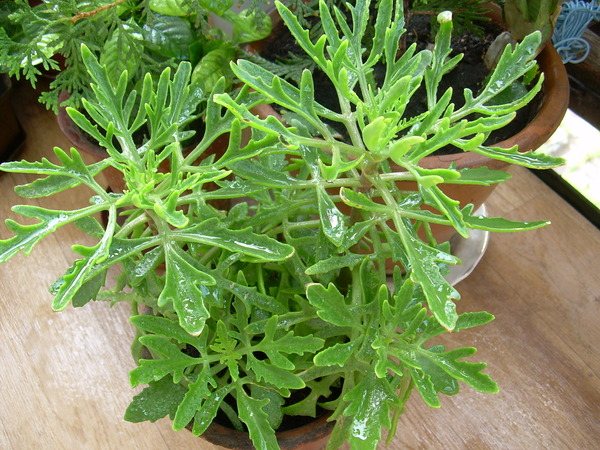

Reindeer horns on your windowsill: all about the bizarre Kalanchoe laciniata
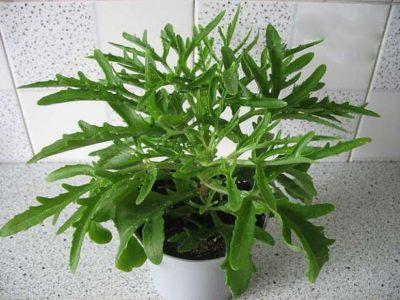

Kalanchoe Laciniata is the most interesting and original flower of all types of succulents. This tropical guest feels great in our climate, is unpretentious, very easy to reproduce and transplant.
It adapts well, grows very quickly. But in order for it to grow into a beautiful decorative bright bush, some features of caring for it are required.
From the article you will learn what this type of Kalanchoe looks like, how to care for it, and also how to deal with pests.
Reproduction of platycerium or flathorn
At home, the fern reproduces by lateral processes that form between overlapping leaves. Young Platyceria grow between leaf blades, which makes it very difficult to separate them. Therefore, the procedure for separating the process is carried out during transplantation, very carefully with a sharp knife, trying not to damage the leaves. The separated young flathorn is planted in a separate container, as an independent plant. Until the fern takes root, it is placed in a greenhouse in order to create a favorable level of air humidity.


Platycerium bifurcatum.
At home, this fern is not propagated by spores, due to the particular difficulty of caring for seedlings.
Growing up, leaving
Landscape designers have long appreciated the unpretentiousness, luxurious, decorative appeal of the sumac tree. It became a full-fledged member of the alleys, parks, gardens, orchards. But not all gardeners are familiar with it.
It is a dioecious plant that fits perfectly into any design. Its crown always disposes to rest in the shade of unusual, dense branches. In order for it to please with beautiful fruits, two trees should be planted - female and male, and they will begin to bear fruit already in the fourth year.
Care errors, diseases, pests
The following problems may arise:
- foliage turns yellow: a sign of fever or sunburn;
- fronds become lethargic and pale: excessive lighting or lack of fertilizer;
- dried up and turned brown: lack of moisture;
- withered: its excess;
- lack of growth: a sign of low humidity.
Platiterium practically does not get sick, only the death of roots is dangerous during stagnant water and excessive watering. When pests appear (thrips, aphids, scale insects, spider mites), insecticides are used for spraying.
general information
Even among the impressive variety of succulents, Kalanchoe laciniata stands out for its unusual appearance and abundant flowering. Representatives of the genus come from South Africa, Asia and the South African tropics.
It is interesting! Deer horns Lanitsiata was nicknamed for the foliage of an unusual shape, it really resembles the twisted, branched antlers of a deer.
This succulent is a herbaceous perennial with succulent, fleshy shoots. In young plants, they are erect, but with age they lie down, and even later they become naked.
Leaves of an unusual shape, with deep cuts and serrated edges. The color of the foliage is light green, bright, they are shiny, as if covered with a waxy layer. Deer horns are inferior in popularity to other colorful Kalanchoe species, however, they are very popular with lovers of exotic flowers.
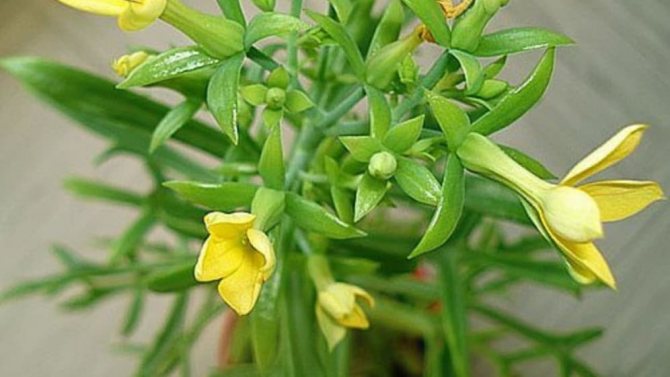

Wednesday, 22 January 2019
Kalanchoe dissected deer horns: care of Kalanchoe laciniata
|
| Kalanchoe dissected - photo |
One of the most interesting plants on my windowsill is Kalanchoe laciniata. For the unusual shape of the leaves, it is also called Reindeer Horns (Reindeer Horns). And as for me, they even look like fleshy needles. Today - caring for this beautiful succulent.
Kalanchoe dissected (dissected-leaved) is an unpretentious houseplant. This means that it can adapt to unfavorable conditions of detention. But in order for this green friend to please with a decorative look, it is better to listen to his requirements - and observe them. Moreover, the "rider" of such a plant is quite simple.
|
| Kalanchoe laciniata - photo |
Caring for Kalanchoe laciniata
Lighting
... Like many other indoor Kalanchoe, Antlers love bright light. This green friend thrives on east, west, southeast and southwest orientation windows. Worse - in the north (additional lighting is needed). The south side is also suitable for him.
But, if for a long time this succulent was in an insufficiently lit place, as well as after a winter with little sun, it must be accustomed to direct sunlight gradually. Otherwise, there may be stains and burns on the leaves.
Attention! Due to the extremely unusual type of plant, some flower growers often want to put it in the back of the room - to decorate the interior. It can be done. However, at the same time, reduce watering to a minimum. And do not keep the succulent in a semi-shady place for more than three weeks - otherwise it will wither. Artificial lighting alone is not enough for the dissected one
.
|
| Kalanchoe "Deer Horns" loves light |
Watering
... As with other succulent plants, careful. This is the only thing that can cause difficulties: with excessive irrigation, the Kalanchoe laciniata has a high probability of trunk decay. However, with our method of caring for plants, excessive watering, as a rule, does not threaten a green friend.
But excessive drought is also undesirable for Deer Horns. It will not lead to the death of this phytoexot. But it will cause drying of the leaves, as a result of which the plant will lose its decorative effect. The appearance of dry, wrinkled foliage is a signal: the plant is thirsty.
I chose the following watering regime for my green pet: in winter - once a week, and on warm and hot days in summer, late spring and early autumn - 2 times a week.
Resistant to dry air
... High. The plant may well be kept near batteries in winter. This tax does not require spraying. But on especially hot days, you can approach it with a spray bottle.
Temperature
... Such a succulent plant tolerates heat well. In winter, you can choose two conditions of keeping: warm (at room temperature) and cold "succulent". But in this case, such an inhabitant of the flowerpot can shed the leaves, which will then grow back in the spring.
Transfer
... As needed. The plant has a weak root system, so you can take a shallow pot. Or make a very good drainage layer.
Extraordinary features of the tree
The botanical gardens of England, only thanks to this plant, are especially decorative in winter. Indian tribes have been using it in everyday life since ancient times. Sweet and sour fruits serve as the basis for drinks, leaves saturated with tannins (polyphenols of natural origin), bark, with a high content of tannins, are used in home medicine. As an astringent, it is indispensable for softening and dressing leather. The fruits are used in the manufacture of highly durable fabric dyes.
"Sumakh-deer" in our latitudes grows only up to four meters in height, at home - up to ten meters. In our regions with a mild climate, this is a full-fledged tree, in the north it looks like a large shrub.
The North American aborigine looks like a palm tree and is beautiful at any time. To take up more space, he strongly scatters his branches. In spring, they look like a lacy umbrella because of the gracefully curved, velvet leaves up to ten centimeters long. They are distinguished by finely toothed edges, and there are forty of them on one stem. The length of the branches can reach eighty centimeters.
In summer, the plant adorns itself with large numerous inflorescences in the form of candles. These pyramid-brushes are composed of numerous pitted fruits. There are two types of them: female - bright, red, dense and male - green with a yellow tint, loose. They emit a rich vinegar smell with subtle hints of fresh cucumber, which attracts insects. Due to this smell, the plant was given the name - "vinegar" tree.
It looks amazingly interesting in the fall. It was at this time that the peak of the extraordinary decorativeness of sumach comes. Luxurious greenery takes on various picturesque colors, the leaves turn purple, carmine, crimson, scarlet, fiery orange.
In winter, when everything around is lifeless and dull, the plant becomes special. The branches acquire a velvety texture of light brown color. Solitary, branched, sticking up, they look like deer antlers, hence the name sumac "deer-horned". On them, until spring, beautiful clusters of fruits with dark red fluffy hairs remain.
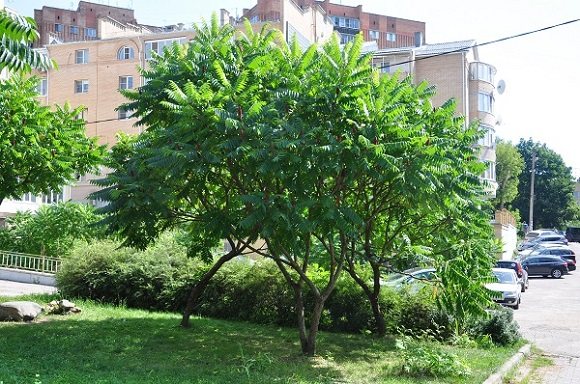

Characterized by its unique, year-round exoticism, the tree is completely unpretentious. It:
- resistant to polluted air
- grows even in poor soils that are not at all suitable for processing, for example, on stony limestone
- thanks to its powerful roots, it can hold the ground of crumbling ravines together
- not particularly demanding for frequent watering (in drought, and then only young trees)
- due to its southern origin, likes a lot of sunlight, but withstands a little shade
- in the adult stage of development, it is resistant to diseases, parasites and pests do not take root on it. The specific aroma scares them off, you can check this by rubbing the leaf in your hands.
- easily tolerates frosts up to thirty degrees - the main and undoubted advantage. Frozen branch tips are quickly restored, and with the onset of spring and summer they are completely invisible. This feature of the plant serves as formative pruning. Long branches are shortened, then continue to branch further, and the tree becomes attractively dense.
This factor is the answer to the question that interests all gardeners - is it possible to cut the deer-horned sumac? The answer is no!
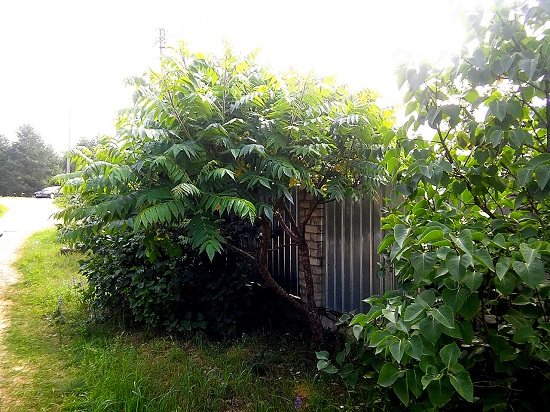

This conclusion appeared after numerous observations. In an area where the tree grows on its own, where no one is pruning, it is small, and the crown is impressively spreading. In trimmed specimens, additional shoots are formed, they grow upward and the crown turns out to be not at all as beautiful as we would like. If you overdo it, it will turn white and the tree will dry out. So, the plant treats interference poorly. The gardener should only remove diseased, dead branches.
How long does the uschus tree live
An unusual plant also has a disadvantage - fragility. Its life cycle lasts only twenty years. But it can revive without any problems with shoots from the roots, capture neighboring areas even at a long distance from the mother tree.
Why is the deer-horned sumac good?
Drought resistance can be safely attributed to the advantages of deer-horned sumach. At home, he lives on the driest and stony soils.
In addition, the plant is also distinguished by winter hardiness, shade tolerance, undemanding to soil fertility - it grows successfully even on stony limestones that are unsuitable for agriculture, and tolerates salinity.
Of the shortcomings, only fragility can be called. By the age of twenty, the trees grow decrepit and soon die. True, sumac quickly recovers from root shoots and root suckers.
Sumac fragrant - decoration of your garden
There is another type of sumac that deserves special attention - sweet sumac (R. aromatica Ait.) - a cute plant with fragrant flowers and branches. Its open crown grows up to 1-3 m in height.
The bark of the shoots is reddish-brown, cracking into thin light stripes.
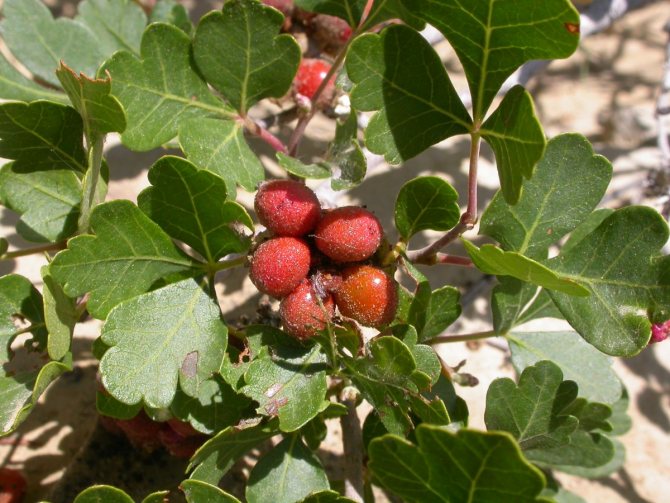

In the first half of May, simultaneously with the blooming of the leaves, small, pretty golden "balls" of dense spike-shaped inflorescences appear at the ends of the shoots.
Each of the three leaves of a complex leaf is colored in autumn in bright carmine colors in the light and yellow in the shade. They, in tone, on the branches ripen spectacular hairy flat-round fruits up to 6 mm long.
Deer-horned sumac - pleases all year round!
In autumn, sumac actively participates in the general riot of colors. The dark foliage gradually turns yellow, and then adds the redness of the anthocyanins, intricately painting the plant.
Having acquired a lace outfit in the spring, the trees bloom in early summer, throwing out large panicle inflorescences. In some trees, male, they consist of small greenish-light yellow staminate flowers. Others, female, - from burgundy-red pistillate. Male inflorescences are loose, up to 30 cm long, and female inflorescences are dense, 25 cm long.
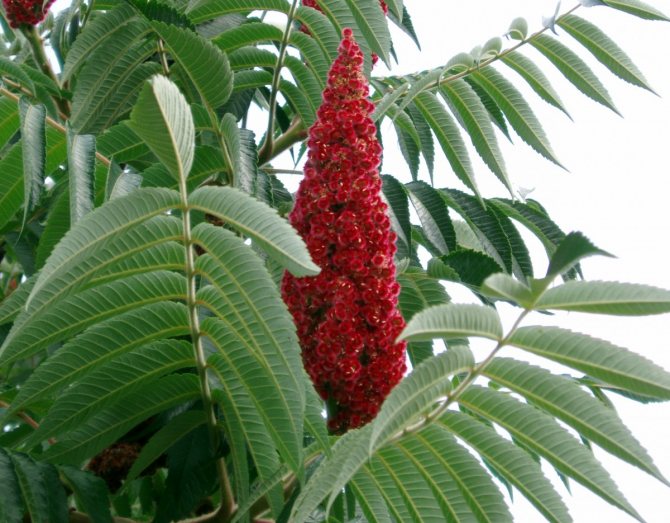

Already in September, the seeds ripen, but even when ripe, the seedlings remain on the tree for a long time.
In winter, you can see their fluffy "horns" sticking out from under the snow.
Description
The culture is a perennial flower of the centipede family, whose homeland is considered to be tropical rainforests. He is a representative of epiphytic ferns, although he does not look like him at all. The plant blooms rarely, but profusely, at this moment tubular inflorescences of a yellow-orange hue appear.
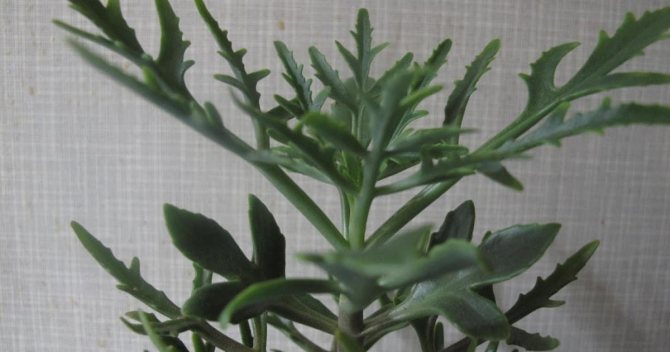

The flower grows slowly. Its juicy, fleshy shoots are covered with brown foliage up to 1 meter in length. They grow from a pith that looks like a head of cabbage. This gives the plant a more exotic look.
Brief conclusions
- Deer antlers are a flower with an unusual foliage shape that resembles deer horns.For this he got his name and fell in love with flower growers. It is not very difficult to grow it at home, the main thing is to follow some rules of agricultural technology.
- One of the main recommendations is to maintain high air humidity, which is not easy to do at home. Spraying with finely dispersed drops, an air humidifier and a tray with expanded clay will come to the rescue.
- For good growth, the culture needs bright, diffused light, high temperature and regular watering. It is imperative to carry out top dressing using special fertilizers. Do not forget about the transplant, which is performed every 2-3 years.
- If desired, the plant can be propagated. The method of growing by shoots is more often used, this is a simple and quick way. Reproduction by spores is sometimes used, but at home flower growers very rarely go this way.
Care features
With proper care, you can ensure the full growth and development of the flower. The plant needs:
- Optimum humidity. Despite the fact that antlers can fully tolerate dry air, spraying is recommended at extremely high temperatures in the summer. For this purpose, a spray bottle is used.
- Correct temperature. The flower is characterized by unpretentiousness in temperature and therefore is fully grown in indoor conditions. In the summer, it is recommended to grow the plant to a temperature of 27 degrees, and in the winter - up to 15 degrees. If the room is too cold, it can lead to damage to the leaves of the plant. In the event that there is an elevated temperature in the autumn and winter, this will exclude the possibility of laying a flower bud.
- Lighting. The houseplant needs to be provided with enough light. In summer, it is recommended to make sure that the daylight hours last at least 12 hours. In winter, the duration of daylight hours should be at least 9 hours. In winter, it is necessary to install the plant on the windowsill on the south side. In the summer, it is recommended to shade the flower, as in case of excessive sunlight, burns may remain on the leaves. In some cases, their redness is observed.
- Watering. Like any other houseplant, antlers need to be watered regularly. Watering is carried out depending on the level of drying of the top layer of soil in the pot. It is strictly forbidden to allow the complete drying of the earthen coma. In winter, watering is carried out twice a week. If there is excess water in the pan, it is recommended to drain it.
- Top dressing. When growing a young plant, fertilization should be carried out twice a month. For this purpose, it is recommended to apply fertilizers for cacti. During the flowering period of deer antlers in winter, fertilizers are used for ordinary indoor plants. Their dose should be halved.
Caring for deer antlers is a fairly simple and responsible procedure. If you follow all the rules for growing a flower, you can achieve high results.
Choice of place and conditions of detention


Let's find out what conditions are most suitable for keeping reindeer horns.
Lighting and location
Fern Platycerium is a shade-loving plant. It does not like the direct rays of the sun. Therefore, it is best to keep the pot with it away from the east and south windows: put it in the back of the apartment. If your windows face west or north, then the antlers can be placed on their windowsills without shading. In winter, additional lighting is not required.
Temperature
In the summer, the Platiterium feels good at temperatures from +20 to +23 o C. But it is better not to allow it to rise to +27 o C and above. In winter, the optimum air temperature is + 15 ... + 19 o C.
Air and humidity
All ferns love high humidity. For deer horns, this figure should be 70-80%. However, in a city apartment, it is difficult to achieve this level of humidity.Therefore, it is better to keep it in such a way that the plant feels comfortable, but does not hurt. For this, a humidity of 60-70% is suitable and regular spraying with water from a spray bottle in the warm season.
It is interesting: Planting and caring for Platicodon in the open field, description of varieties and reproduction
Despite the fact that the fern is very hardy, drafts are dangerous for it. In the wild, other plants protect them from them. And in the apartment, it is even easier to rid the antlers of the cold air flows: put the pot away from the fan, air conditioner and open window.
Soil and pot
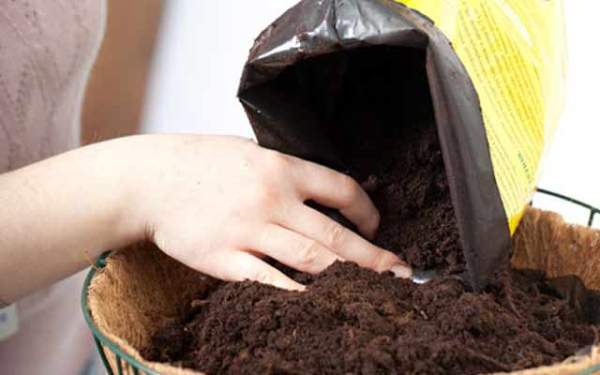

For the cultivation of platycerium, a soil intended for orchids is suitable. You can buy it at a flower shop. A mixture of:
- 2 pieces of leafy land;
- 2 parts of washed river sand;
- 4 parts of high-moor peat;
- 1 part sphagnum moss;
- 1 part chopped pine bark.
The antler indoor flower develops very slowly, therefore it needs a compact pot, the size of which is only slightly larger than the size of its root system. The container material is unimportant. The main thing is that it is not too deep and has drainage holes.
Plant propagation
The easiest way to propagate a houseplant is to divide the rhizome. Other methods are characterized by laboriousness and therefore, in most cases, they are used only by experienced florists.


The spore propagation method is very often used. To do this, you need to take a shallow pot, which in its shape resembles a bowl. Initially, it is recommended to prepare a mixture that includes peat and leaf soil, as well as sand. Before using the mixture, it must be steamed with boiling water without fail. It is recommended to sow spores into the mixture, which is previously placed in a bowl. After this, it is necessary to conduct moderate watering of the plant. For this purpose, a solution of quinosol or potassium permanganate is used. Covering the pots is recommended. For this, glass or polyethylene is used. After the first leaves appear on the sprouts, they are dived into a larger pot separately.
For reproduction of deer antlers, the upper shoot, the height of which is at least 10 centimeters, can be used. The procedure is performed in the spring. The shoot must be rooted in a mixture of peat and sand. After planting it in a pot, it is recommended to cover it with plastic wrap. To ensure the full rooting of the shoot, it is necessary to air it daily.
Plant propagation can be carried out by seeds that are overly small. They are planted at the end of the winter period in leafy ground, where sand is added. Seed germination will already be observed in two weeks. After the emergence of seedlings, it is recommended to dive them.
Deer antlers are a very beautiful flower that can be used to decorate any windowsill in the house. Due to the ease of maintenance, even a novice florist can do it.
An exotic representative of ferns, the antler flower, amazes with its unusual appearance and surprises with its ease of cultivation and care. The decorative properties of this bizarre plant are successfully used in interior decoration. The article and the photos of the flower presented in it will help you understand all the intricacies of growing exotic.

